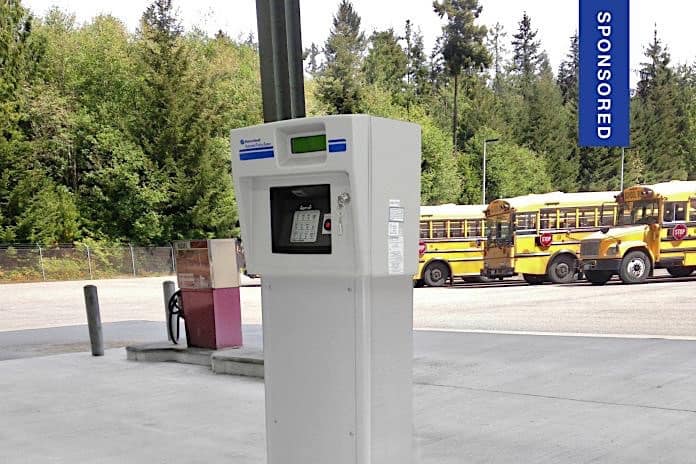For school transportation fleet managers, a fuel budget that bleeds red due to unaccounted fuel losses is a hard lesson in the challenges of fuel management.
All school transportation fleets that manage their own fuel supplies are susceptible to fuel losses that can compromise a school fleet’s bottom line. These losses could result from theft, fuel system leaks, shrinkage, short deliveries, gray loads, meter drift and other causes.
Accurate, comprehensive and efficient reconciliation processes that account for all fuel being pumped into and out of fuel storage tanks is vital to a quality school fleet fuel management program. Many school transportation fleets, though, still perform manual reconciliation through Statistical Inventory Reconciliation (SIR) to audit their tanks’ inventories. However, SIR data collection can be extremely inaccurate and inefficient. Automating reconciliation through a software-driven solution eliminates these challenges.
SIR – An Imperfect System
One of the functions of SIR is to calculate variance, which is the difference between the amount of fuel reported being delivered and the amount of fuel being dispensed. Variance is an indication of the fuel system’s level of environmental compliance as well as the accuracy of the inventory data being collected. If problems stemming from a high rate of variance are not quickly addressed, undetected and unaccounted fuel losses can add up to tens of thousands of dollars in lost fuel.
Many school transportation fleets that manage their own fuel supplies manually reconcile their inventory. There are several drawbacks to this approach:
1. SIR is labor-intensive.
To complete SIR, site operators must record inventory measurements every day that the fuel site is in operation. They must collect measurements for every fuel product on site, the amount of water in each product’s tank, the amount of fuel sold or dispensed and the quantity of fuel supplied during fuel deliveries. To achieve the most accurate analysis of fuel inventories possible, these measurements should be collected at the same time every day. Once the data is obtained, it needs to be entered on an SIR worksheet (or a spreadsheet) and the variance needs to be calculated. Mastering SIR procedures takes practice, vigilance, discipline and diligence. Significant investment in cross-training is usually required to pass along the specialized knowledge required by SIR.
2. Manual data collection is inexact.
The data obtained through SIR is only as good as the personnel and equipment charged with collecting it. Unfortunately, the tools used to “dip the tanks”— wooden gauge sticks — are often deteriorated because of daily wear and tear. In addition, sometimes users modify their gauge sticks to make obtaining measurements easier. Inexact gauge sticks produce inexact measurements, which in turn, result in inaccurate variance calculations. Imprecise variance calculations can lead to bookkeeping inaccuracies, false compliance failures and ineffective overall inventory management. Supply deliveries are especially difficult to assess through manual reconciliation; measurements need to be collected in a timeframe when no dispensing or deliveries occur between the time when the volume in the tank and the volume dispensed is measured.
3. Losses increase incrementally as time elapses and unresolved problems linger.
Determining what is causing a high rate of variance can be especially time-consuming with manual reconciliation. Without the support of software analytics, it can take an operator 30 to 60 days to realize a loss is occurring. Once a loss is identified, resources are required to troubleshoot the cause of the loss and implement solutions. Fuel losses accrued over a couple of months can undercut a fuel budget.
Software Drives Efficiency and Accuracy
Automating reconciliation through a technology-driven solution, such as OPW’s Phoenix SQL Fuel Management Software, delivers many benefits to school transportation fleets:
- Streamlines work processes by eliminating manual data collection
- Significantly improves the accuracy of reconciliation data
- Minimizes false compliance failures
- Enhances a site’s fuel consumption forecasting with real-time data collection
- Reduces costs associated with troubleshooting the cause of unaccounted fuel losses
- Creates compliance reporting efficiencies
In addition to automating reconciliation, Phoenix SQL interfaces with most fleet maintenance and back-office software programs, enabling school transportation fleet managers to fully maximize their fueling data. It also reveals obvious, incorrect mileage entries (such as single sequential or repeated numbers) through enhanced odometer checks, and it streamlines tank-strapping configuration procedures by eliminating duplicative data entry processes.
Designed to help protect a school district’s bottom line, fleet fuel management software like Phoenix SQL can capture return on investment in as little as a year. Some fuel sites may be able to upgrade select components (such as deploying a software-driven reconciliation solution) within an existing fueling system. By reducing unaccounted fuel losses through automated reconciliation practices, fuel districts have much to gain from software-driven fuel management solutions.
Learn more about OPW Fuel Management Systems.
















